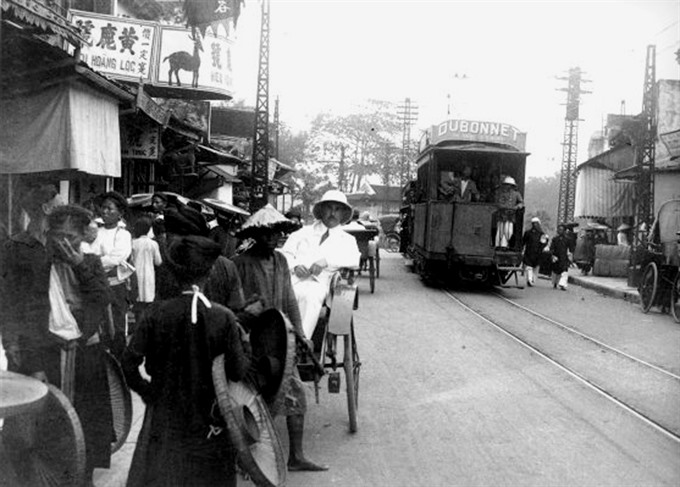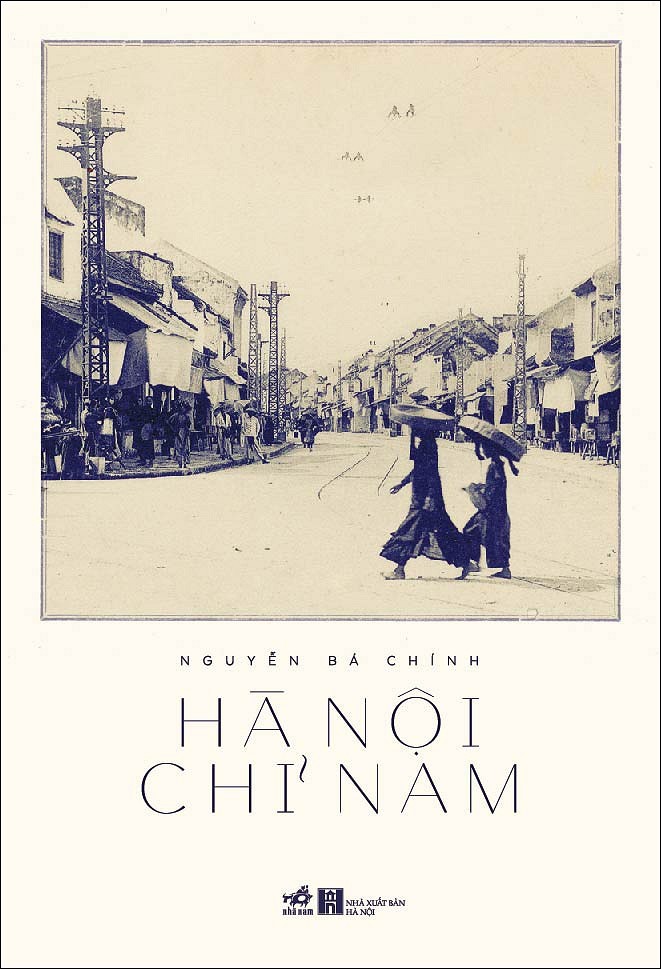 Features
Features

A classic travel guide authored early in the 20th century has been reprinted, offering readers the opportunity to travel back in time and experience yesteryear Hà Nội in minute detail.
 |
| Then: A tram in Hàng Đào Street in 1920s. Photo wordpress.com |
By Trinh Nguyễn
A classic travel guide authored early in the 20th century has been reprinted, offering readers the opportunity to travel back in time and experience yesteryear Hà Nội in minute detail.
Nhã Nam Books, in co-operation with Hà Nội Publishing House, has brought out a new edition of the original Hà Nội Chỉ Nam (Hà Nội Travel Guide), considered a thorough guide book in the early 20th century.
Authored by Nguyễn Bá Chính, the guide book was first printed in 1923 with clear information about Hà Nội’s tram routes, railway, roads, restaurants, hotels, pharmacies and tailors.
Apart from the wealth of information, the book also encouraged readers to follow the writer’s choices and recommendations.
“This is a new guide book written in the Romanised Vietnamese script, targeting Vietnamese people, travellers and enterprises as the demand for travel keeps increasing in such a beautiful city, which will be a big market soon,” Chính wrote in 1923.
The book lists four tram routes in the city, all starting from Hoàn Kiếm Lake.
It notes: “A one-way ticket on leather seat costs 4 cents; ticket for a normal seat, 3 cents; ticket for children 3-7 years old, 2 cents. A return ticket on leather seat costs 7 cents; on normal seats, 5 cents; for children 3-7 years old, 3 cents.
“The Tram Department sells monthly tickets for 2 or 4 routes.”
The guide book also lists distances between Hà Nội and other provinces, details of rail routes and information on how to buy tickets.
The book clearly sets out the rail route from Hà Nội to Yunan (China) and procedures to get a pass for both French and Vietnamese people. The readers were advised to submit the pass form to French authorities in the Hà Khẩu (border area with Yunan, China in the northern province of Lào Cai) three days before departure.
It also carried a reminder: “Passengers with weapons should show the weapons to the French authorities at the time they submit the pass forms. If they do not have permission from Chinese authorities at the border, they cannot bring weapons into Yunnan.”
“It’s a bit of an exaggeration to call this a historical or anthropological document as it is a travel guide,” researcher Phan Phương Thảo of the History Department, Hà Nội University of Social Sciences and Humanities, told Thanh Niên (Young People) newspaper.
“There are clearer documents stored at No 1 Archive Centre in Hà Nội. Yet in terms of a travel guide book for that time, the information is quite clear, concrete and precise. It’s a useful guidebook for both Vietnamese and French people.”
She noted further that Hà Nội Chỉ Nam lays out clear travel routes, highlights beauty spots within the city, on its outskirts and further.
The Hà Nội Opera House is introduced thus: “Locating at the head of Tràng Tiền Street, an outstanding, magnificent building is the so called ‘Municipal Theatre ’.
“The House was built in 1901, on the area of a lake. As many as 35,000 wooden pillars were installed, a 90cm-thick layer of cement and pebblestones was poured to make its foundation.”
Attention to detail
The book explains things like why the statue of Huyền Thiên Trấn Vũ at the Quán Thánh Temple is covered with a yellow robe: “It was made totally of black copper. People dubbed it as statue of Black Copper Saint. The statue was given a royal robe by King Thiệu Trị (1807-1847) during his trip to the north…
Though the temple was built a long time ago, trees have been planted and new buildings have been newly erected.”
“This detail is interesting,” said Phạm Thanh Hương, an expert with UNESCO Việt Nam. “Today, the statue no longer wears a yellow coat. The information will help today’s tour guide to add more interesting details to their presentation on the temple.”
The information on Hoàn Kiếm Lake states that the Lê Dynasty (1427-1789) used the lake as a site for training marine forces. That’s why the lake used to be called “Hồ Thủy Quân” (Naval Lake).
The book tells the reader where she/he can get photographs taken, buy souvenirs, leather goods, jewelry, silk, cloth, etc.
In the part for restaurants and accommodation, the writer divides the establishments into three categories: westerners, Chinese and Vietnamese.
The list for western restaurants is led by Hotel Metropole.
The writer has clearly opted for big restaurants with tasty and hygienic food.
The 155-page book, costing VNĐ50,000 (US$2.2) is available in book stores throughout the country.
Đỗ Đình Hồng, director of Hà Nội Tourism Department said the department intended to publish a new guide book, which may contain the same subheads.
The accommodation list may contain 5-star, 4-star, 3-star, homestays and apartments.
The new book, to be published later this year, will also have information on venues for art shows. — VNS
 |
| Sacred relic: Statue of Huyền Thiên Trấn Vũ at Quán Thánh Pagoda. VNS File Photo |
 |
| Then: Cover of Hà Nội Chỉ Nam by Nguyễn Bá Chính. |




